.jpg)

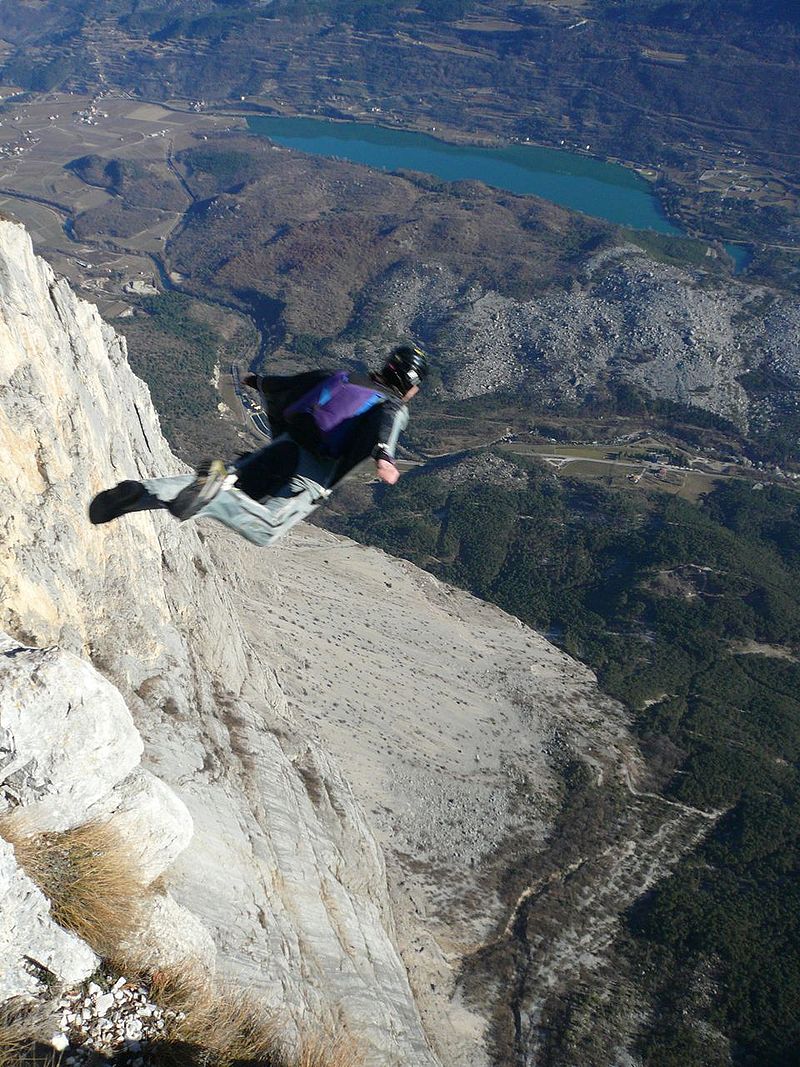
.jpg) |
 |
 |
|---|---|---|
An wing generates lift at the cost of drag. Lift exceeds drag.
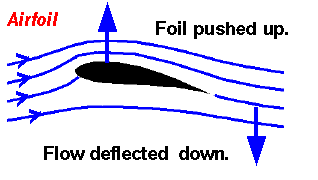 |
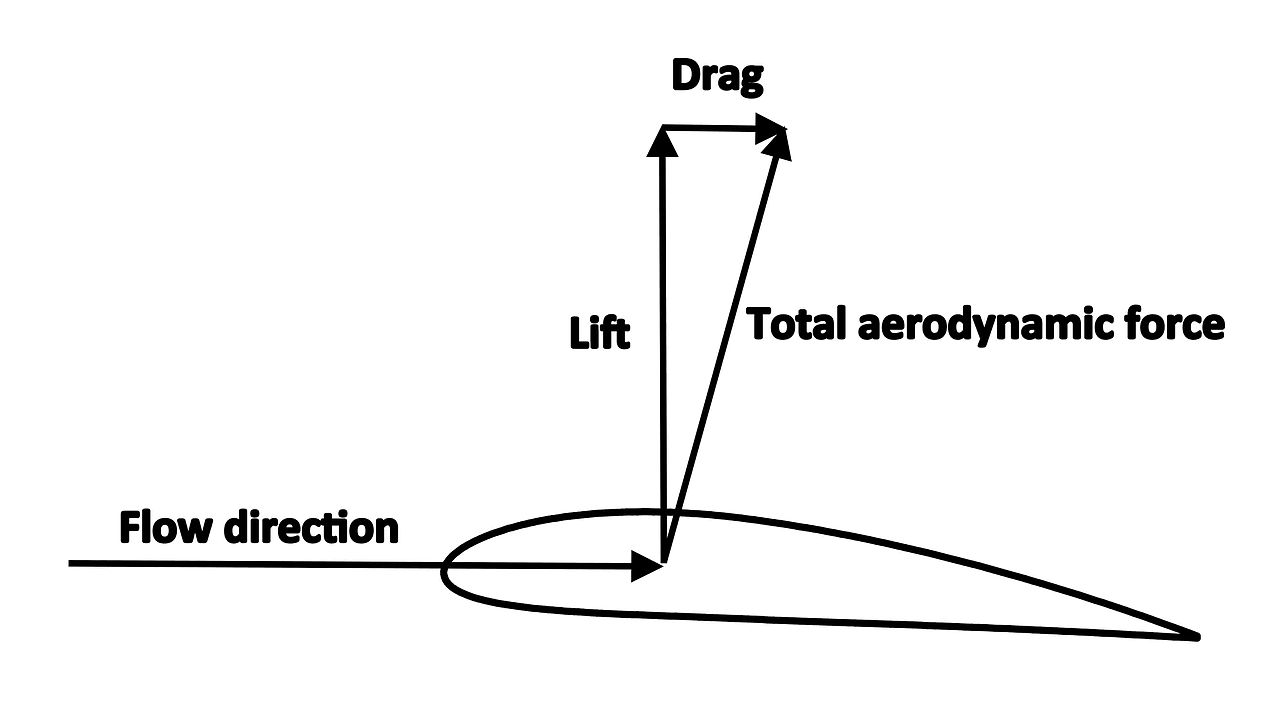 |
|---|---|
Wing drag force = F→ Wing lift force = F↑ Wing lift-to-drag coef.= Qw = F↑ / F→
The lift-to-drag coefficient Qw is proportional to wing length divided by wing width.
Wing length = L Wing width = W Wing lift-to-drag coef.= Qw ~ L/W = Wing aspect ratio.
Wing width varies along the length of the wing. We define an effective width as
Width = ½ Area / Length
"Area" is the total for both wings, and "Length" is for one wing.
Aspect ratio is Length/Width.
Qw Aspect Wing Wing Wing
ratio length width area
meter meter meter2
U-2 23 10.6 High-altitude spy plane
Albatros 20 1.7 Largest bird
Gossamer 20 10.4 14.6 1.4 41.3 Gossamer albatross, human-powered aircraft
Hang glider 15
Tern 12
Herring Gull 10
Airbus A380 7.5 7.5 36.3 11.6 845
Concorde 7.1 .7 11.4 15.7 358.2
Boeing 747 7 7.9 23.3 11.3 525
Cessna 150 7 2.6 4.5 1.7 15
Sparrow 4
Human wingsuit 2.5 1 1.0 1.0 2
Flying lemur ? Most capable gliding mammal. 2 kg max
Flying squirrel 2.0
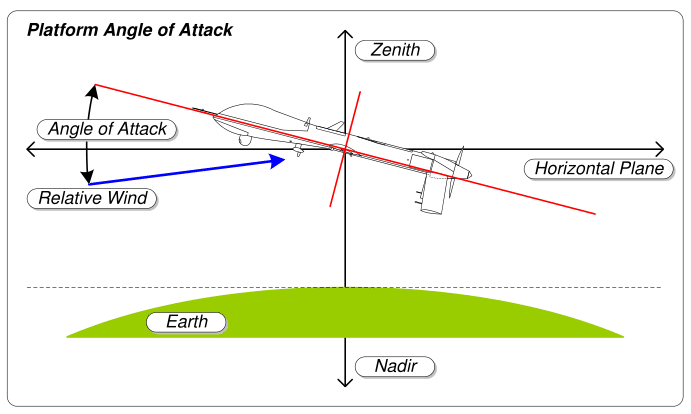 |
|
|---|---|
Changing wing angle changes lift and drag. There is an optimum angle that maximizes the lift-to-drag coefficient.
If the angle is larger than the optimal angle, you gain lift at the expense of drag. If you make the angle of attack too large, lift ceases and the plane stalls.
The air drag force is
Air density = D = 1.22 kg/meter2 Velocity = V Cross-sectional area = A Drag coefficient = C Drag force = F = ½ C D A V2
Human mass = M = 80 kg Gravity = g = 10 meter/second2 Gravity force = F↓ = 800 Newton Chute drag coefficient = C = 1 Dimensionless Air density = D =1.22 kg/meter2 Parachute area = A = 100 meter2 Drag force = F↑ = ½ C D A V2 = F↓ Terminal velocity = V = 3.6 meter/second
Drag force = F = ½ C D A V2 Drag power = P = F V = ½ C D A V3
Drag coef Drag area Power Max speed
dimensionless meter2 Watt meter/second
Bike 1 .5 400 11
Car .4 3 300000 74
Cw
F-4 Phantom .021 (subsonic)
Cessna 310 .027
Airbus A380 .027
Boeing 747 .031
F-4 Phantom .044 (supersonic)
 |
|---|
A glider is unpowered. The more efficient the glider, the smaller the glide angle. The minimum glide angle is determined by the wing lift/drag coefficient.
Drag force = F→ Lift force = F↑ = Fgrav Wing lift/drag ratio = Qw = F↑ / F→ Horizontal speed = V→ Vertical descent speed = V↓ Glide ratio = G = V→ / V↑ Gravitational force = Fgrav Drag power = Pdrag = F→ V→ Power from gravity = Pgrav = Fgrav V↓If the glider descends at constant velocity,
Pdrag = PgravThe goal of a glider is to maximize the glide ratio
V→ / V↓ = (Pdrag / F→) / (Pgrav / Fgrav)
= Fgrav / F→
= Qw
The glide ratio is equal to the lift coefficient. Qw = G
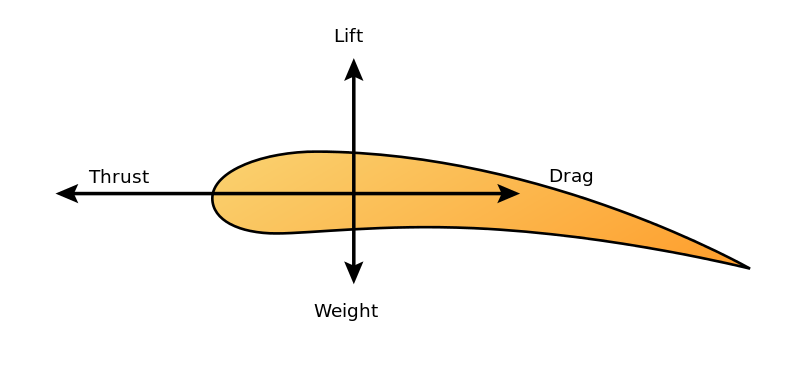 |
|---|
Air density = D Wing area = A Wing drag coefficient = Cw Wing drag = F→ = ½ Cw D A V2 Wing lift = F↑ Wing lift/drag ratio = Qw = F↑ / F→ Aircraft speed = V Aircraft mass = M Gravity = g = 9.8 meters/second2 Gravity force = Fgrav= M g Engine force = Feng = V F→ Drag power = P→ = F→ V = ½ Cw D A V3 Agility (Power/mass) = p = P→ / M = V g / QwFor flight at constant velocity,
Feng = F→ Horizontal force balance F↑ = Fgrav Vertical force balance F↑ = F→ Qw Definition of the wing lift/drag coefficient Fgrav= Fdrag Qw → M g = Qw ½ Cw D A V2 Cruising speed = V = M½ g½ Qw-½ (½ Cw D A)-½ ~ M1/6 Agility (Power/mass) = p = M½ g3/2 Qw-3/2 (½ Cw D A)-½ ~ M1/6 Aircraft energy/mass = e ~ M0 Flight time = T = e/p ~ M-1/6 Range = X = V T ~ M0
For the mass scalings, we assume that wing area scales as M2/3.
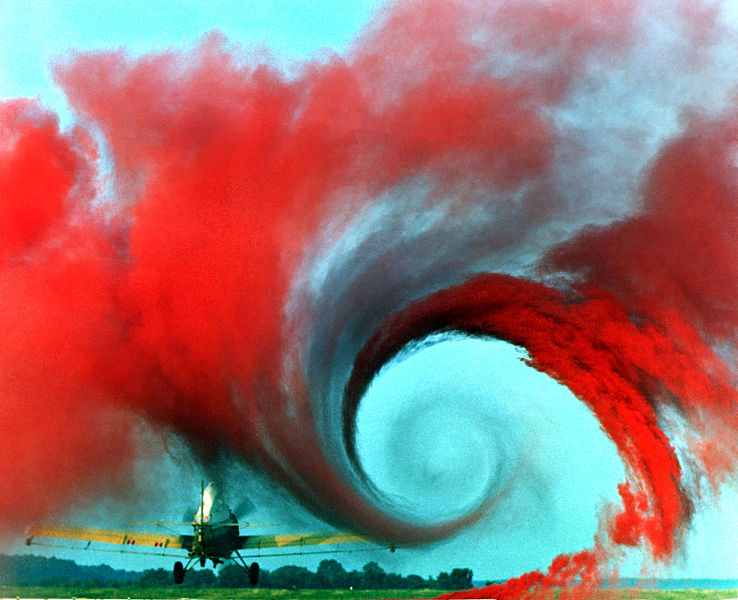 |
|---|
A wingtip creates a vortex as it moves. Wingtips are often equipped with a vertical element to damp the vortex. The vertical element increases the effective wing length and improves the lift-to-drag coefficient. coefficient.
Birds fly in a "V" formation to use the updraft from their neighbor's wingtip vortices.
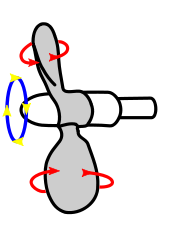 |
|---|
For propellers,
Rotor radius = R
Air density = D = 1.22 kg/meter3 at sea level
Rotor tip speed = V
Rotor width param= Cr
Rotor lift force = F↑ = D Cr R2 V2
Rotor drag force = F→
Rotor lift/drag = Qr = F↑ / F→
Rotor power = P = F→ V = F↑ V / Qr
Rotor force/power= Z = F↑/ P
= Qr / V
= R F↑-½ D½ Cr½ Qr
= R F↑-½ D½ qr
Rotor quality = qr = Qr Cr½
The physical parameters of a propeller are {Qr,Cr,qr}, with typical values of
Qr = 5.5 Cr = .045 qr = 1.17Most propellers have 2 blades and some have 3. If there are 4 or more blades then qr declines.
The parameters are not independent. They're related through the blade aspect ratio.
K ≈ Aspect ratio Cr ≈ K-½ Qr ≈ K qr ≈ K½
Aircraft mass = M Gravity = g Aircraft force = F↑ = M g Rotor radius = R ~ M1/3 Hovering force/power = Z = qr D½ R F↑-½ ~ M-1/6 Hovering power/mass = p = g / Z ~ M1/6 Aircraft energy/mass = e ~ M0 Hovering time = T = e / p ~ M-1/6
A drive propeller has to move substantially faster than the aircraft to be effective. This distinguishes it from a hovering propeller, which is designed to minimze propeller speed.
Rotor radius = R Air density = D = 1.22 kg/meter3 Aircraft speed = U Rotor speed coef. = s Rotor tip speed = V = s U Rotor lift force = F↑ Rotor drag force = F↓ Rotor lift/drag = Qr = F↑ / F↓ Rotor power = P = F↓ V = F↑ V / Q Rotor force/power = Z = Q / VTypically, Q ~ 5.5 and s ~ 3.
A commonly-appearing quantity is the power/mass ratio, which is inversely proportional to the force/power ratio.
Mass = M Gravity = g Rotor quality = q Hover force = F = M g Hover power = P Force/Power ratio = Z = F/P Power/Mass ratio = p = P/M = g/Z
Air density = Dair= 1.22 Seawater density = Dwater= 1025 Gravity = g = 9.8 meters/second2 Wing drag coef. = Cw = .03 Wing Lift/drag = Qw = 7 Rotor lift/drag = Qr = 5.5 Rotor width param = Cr = .045 Rotor quality = qr = 1.17 = Qr Cr½ Rotor force/power = Zr Rotor agility = pr = g/Zr Wing agility = pw
Aircraft mass = M Gravity = g Air density = D = 1.22 kg/meter3 Aircraft speed = U Rotor speed coef. = s Rotor tip speed = V = s U Aircraft lift force = F = M g Rotor lift force = F↑ Wing lift/drag = Qw = F / F↑ Rotor drag force = F→ Rotor lift/drag = Qr = F↑ / F→ Rotor power = P = F→ V = F↑ V / Qr = F V / (Qr Qw) Aircraft force/power = Z = F / P = [Qr Qw / s] / UThere is a tradeoff between Qr and s.
The larger the number of rotors, the less power is required to fly. The efficiency of a rotor is characterized by the force per power.
Number of rotors = N
Aircraft mass = M
Total rotor mass = m
Rotor mass = m/N
Rotor constant = C
Rotor radius = R = C m1/3 N-1/3
Gravity = g
Force per rotor = F = Mg/N
Rotor quality = q = 1.17
Air density = D = 1.22
Rotor quality = Q = q D½ = 1.29
Rotor force/power = q D½ C (m/N)1/3 (Mg/N)-½
= q D½ C N1/6 m1/3 M-½ g-½
For example, in dimensionless units,
Rotors Rotor Rotor Rotor Rotor
mass radius force force/power
1 1 1 1 1
2 .5 .79 .5 1.12
3 .33 .69 .33 1.20
4 .25 .63 .25 1.26
6 .167 .55 .167 1.35
8 .125 .50 .125 1.41
16 .062 .40 .062 1.59
 |
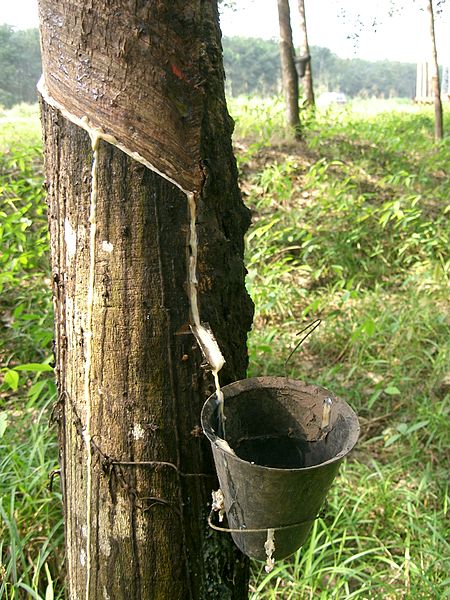 |
|---|---|
 |
 |
 |
|---|---|---|
Rubber has many types, with widely-varying elastic properties. For an aircraft motor, what matters is energy/mass, and butyl rubber does well.
Tensile yield strength = t Tensile modulus = Γ Yield strain = Δ = t/Γ Density = ρ Elastic energy/volume = E = ½ Γ Δ2 Elastic energy/mass = e = ½ Γ Δ2 / ρ
Tensile Tensile Yield Density Tensile Common
modulus yield strain (g/cm3) energy/mass name
(GPa) (GPa) (kJoule/kg)
Rubber, butyl .007 .020 7 .92 186
Rubber, natural .003 .025 8 .92 104
Rubber, styrene .006 .0175 4.75 .94 54
Rubber, polyurethane .006 .025 3.75 1.25 34
Rubber, nitrile .004 .015 3.5 1.0 19.6
Rubber, silicone .00066 .0073 7.4 1.25 14.4
Rubber, poly .015 .005 .92
Rubber, neoprene .020 .0025 .12 1.23 1.2 Chloroprene
Cotton 15 .5 .1 1.5 50
Gut .2
Aramid 135 3 .022 1.43 22.8 Kevlar
Polyamide 5 1 .2 1.14 88 Nylon, Perlon
Polyester 15 1 .067 1.38 24
HMPE 100 2.4 .024 .97 30 Dyneema, Spectra
Vectran PBO 280 5.8 .021 1.52 41 Zylon
Vectran LCAP 65 3.8 .058 1.4 78
Vectran HT 75 3.2 .043 1.41 49
Vectran NT 52 1.1 .021 1.41 8.1
Vectran UM 103 3 .029 1.41 31
Spider silk 10 1.6 .16 1.56 82
Carbon nanorope 1050 3.6 .0034 1.34 4.5
Graphene 1050 160 .152 1.0 12000
Carbon fiber 181 1.6 .0088 1.8 3.9
Magnesium alloy 45 .26 .0058 1.74 .43
Aluminum alloy 70 .41 .0059 2.70 .45
Titanium alloy 116 1.10 .0095 4.51 1.16
Steel alloy 211 1.5 .0071 7.9 .67
For rubber, the numbers for energy/mass are estimations. To get accurate numbers, you need to integrate the full stress-strain curve, and it's nonlinear.
The table is incomplete. Experiments are needed.
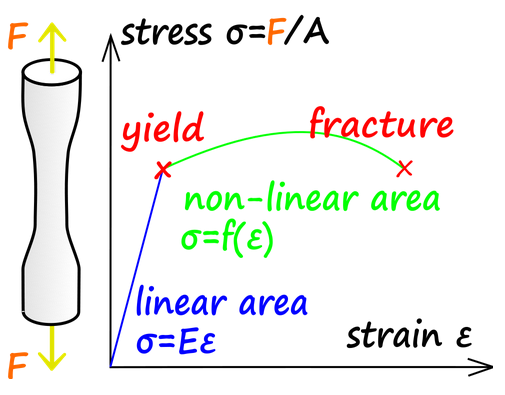 |
|---|
Tensile Density Set Cure
strength time time
MPascal gram/cm3 hour hour
Epoxy 50 1.18 5 42
Cyanoacrylate 27 1.1 .01 24
Polyvinyl acetate 25 1.19 .3 24 Elmer's glue
Polyurethane 24 1.5 18
UV glue 20 - .01
Silicone rubber 8 1.24 1 42
Rubber cement 5 1.06 .1 12
Duct tape .01 .01 .01
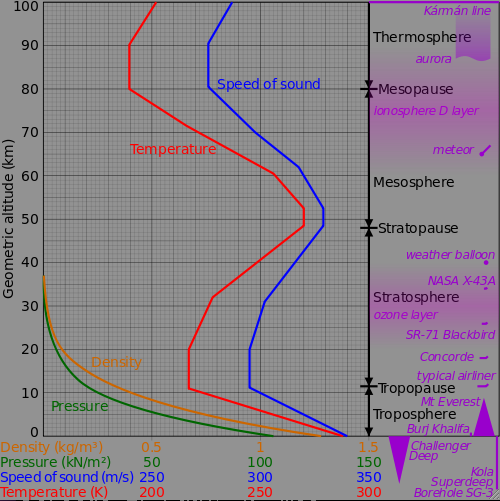 |
|---|
Altitude Density
(km) (kg/m3)
Sea level 0 1.22
1 1.14
2 1.02
Cessna 150 3 .79
Mount Everest 8.8 .46
Boeing 747 11.0 .36
Airbus A380 13.1 .26
Concorde 18.3 .115
F-22 Raptor 19.8 .091
U-2 21.3 .071
SR-71 Blackbird 25.9 .034
 |
|---|
The most important quality of an engine is power/mass, and the value increases over time. Flight was enabled by the invention of an engine with sufficient power/mass.
Engine Power/Mass Year Type
W/kg
Newcomen engine .5 1712 Steam
Stirling 6 1816 Stirling
Watt engine 2 1776 Steam
Stephenson 5 1829 Steam
Otto 10 1876 Liquid fuel 12% efficient. 3 hp
Wright Flyer 116 1903 Liquid fuel
Gnome Omega 493 1909 Liquid fuel
Mercedes D.I 395 1913 Liquid fuel
Mercedes D.II 426 1914 Liquid fuel
Mercedes D.III 385 1914 Liquid fuel
Rolls Royce Hawk 319 1915 Liquid fuel
Le Rhone 9C 565 1916 Liquid fuel
Mercedes D.III+ 491 1918 Liquid fuel
Liberty L12 779 1917 Liquid fuel
Japanese Zero 1429 1939 Liquid fuel Nakajima Sakai 21 engine
Mass 274 kg Max takeoff mass 338 kg Engine power 8900 Watt Engine mass 77 kg Engine power/mass 116 Watts/kg Aircraft power/mass 32 Watts/kg
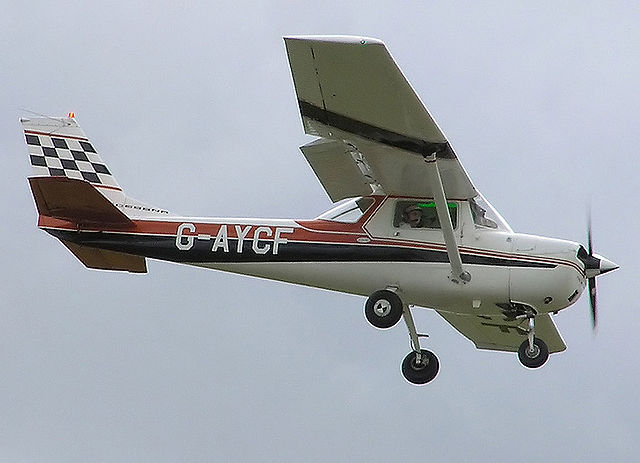 |
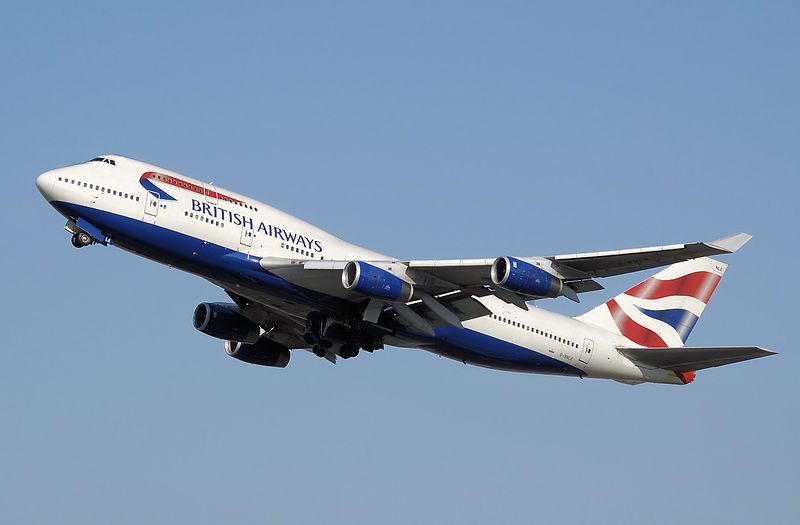 |
_arrives_London_Heathrow_11April2015_arp.jpg) |
|---|---|---|
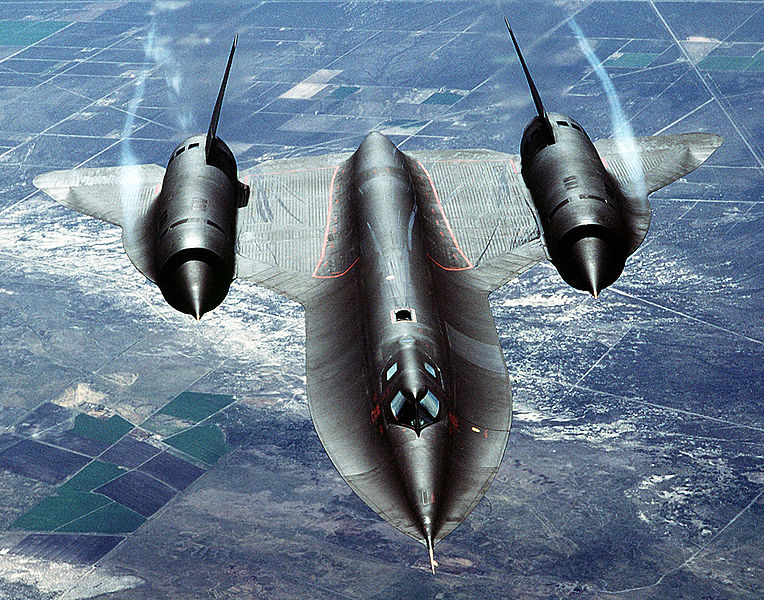 |
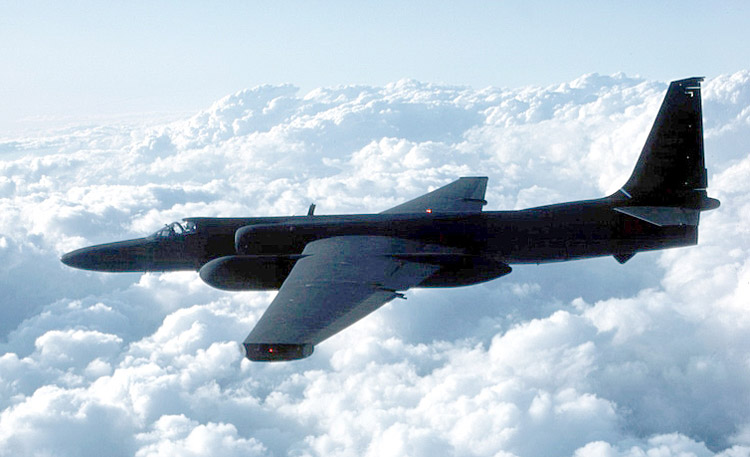 |
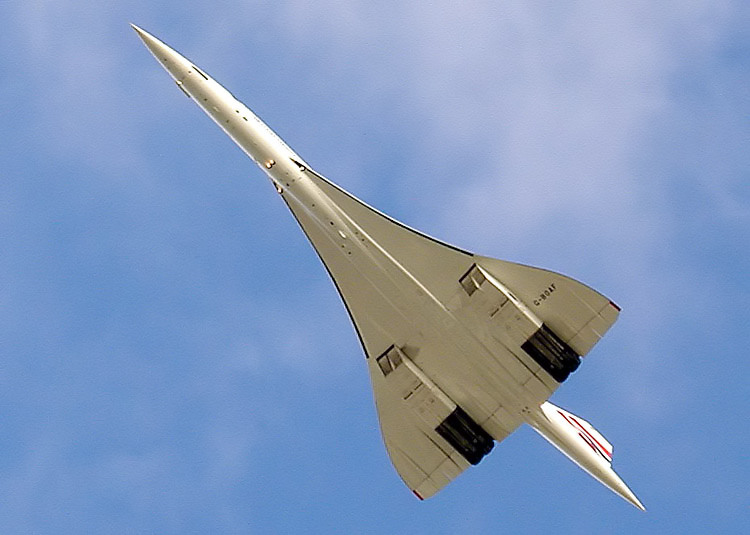 |
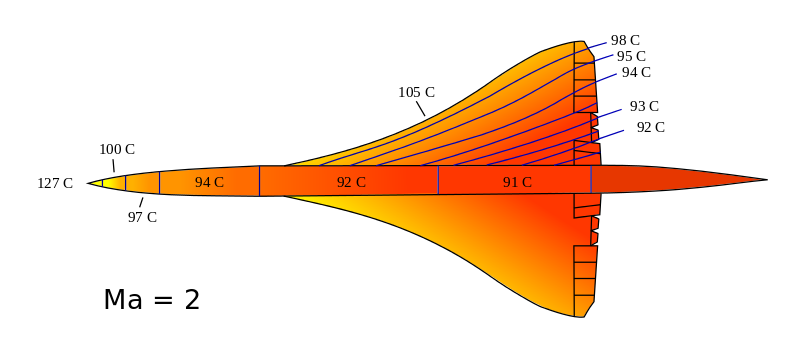 |
|---|---|---|---|
Vcruise Vmax Mass Takeoff Ceiling Density Force Wing Len Wing Range
m/s m/s ton ton km kg/m3 kN m2 m m km
Cessna 150 42 56 .60 .73 4.3 .79 1.34 15 7.3 10.1 778
Boeing 747 254 274 178.1 377.8 11.0 .36 1128 525 70.6 64.4 14200
Boeing 787-9 251 262 128.9 254.0 13.1 .26 640 360.5 62.8 60.1 14140
Airbus A380 243 262 276.8 575 13.1 .26 1360 845 72.2 79.8 15200
Concorde 599 605 78.7 190.5 18.3 .115 560 358.2 61.7 25.6 7223
F-22 Raptor 544 740 19.7 38.0 19.8 .091 312 78.0 18.9 13.6 2960
U-2 192 224 6.49 18.1 21.3 .071 84.5 92.9 19.2 31.4 10308
SR-71 954 983 30.6 78.0 25.9 .034 302 170 32.7 16.9 5400
Mach 1 = 298 m/s.